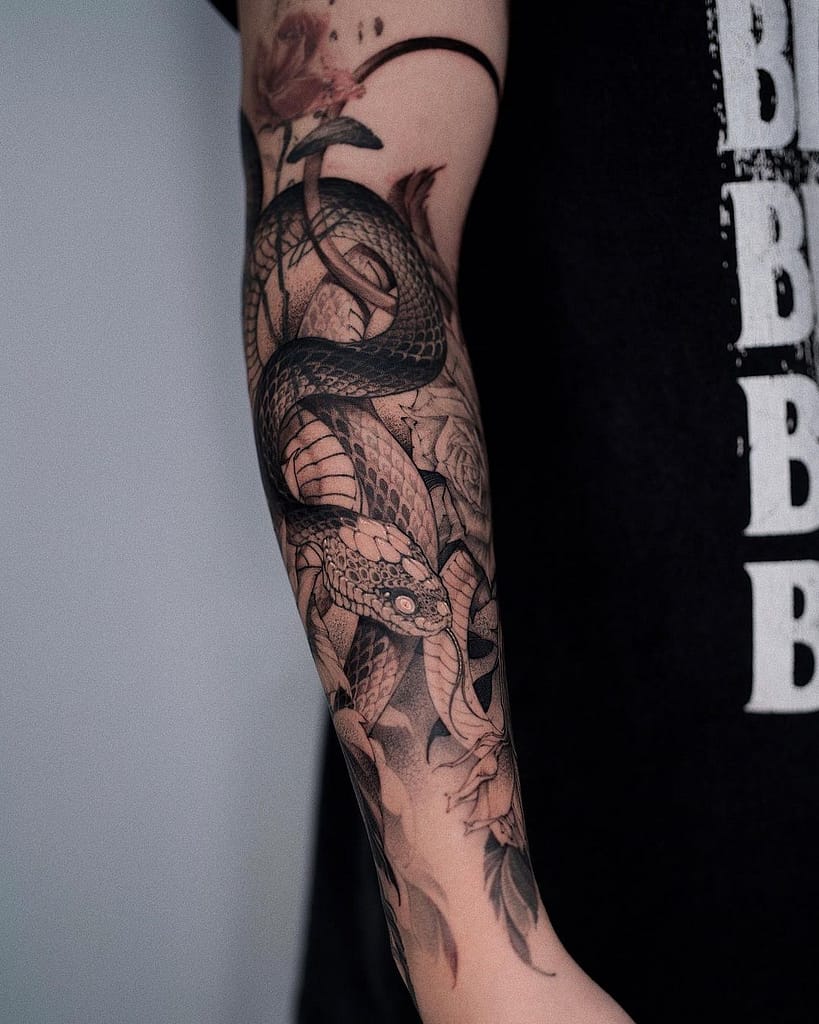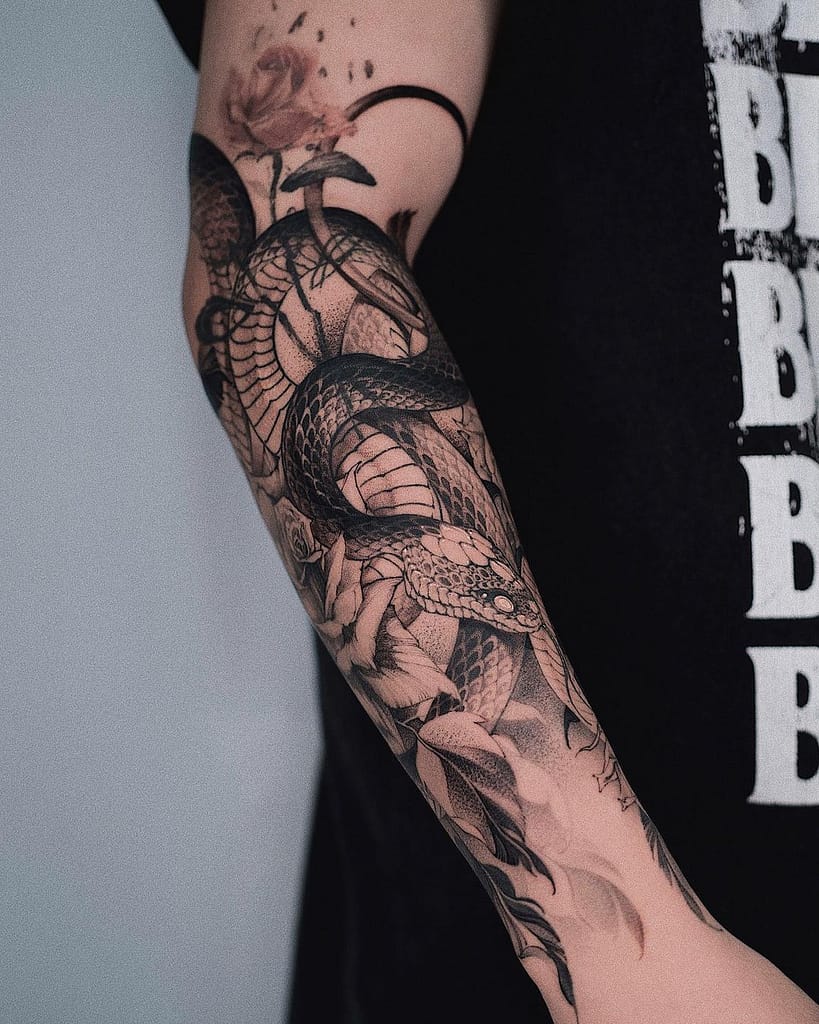Have you ever wondered why the snake, a creature often feared and revered, is such a popular choice for tattoos? Snake tattoos are not just about aesthetics; they carry a depth of symbolism and meaning that transcends cultures and history. From the ancient Egyptian pharaohs to the intricate Japanese Irezumi, snake tattoos have been a symbol of power, wisdom, and rebirth.
Let’s dive into the fascinating world of snake tattoos, exploring their rich symbolism across various cultures. Whether you’re considering getting a snake tattoo or are simply curious about its meaning, this journey will unveil the layers of significance behind these captivating designs. So, Let us unravel the riddle of “What Does A Snake Tattoo Mean?” and discover 20 unique designs that might inspire your next ink.
Join me, Ashwani Srivastava, as we explore the intriguing and diverse world of snake tattoos, where each curve and colour tells a story deeper than the skin.
Table of Contents
What Does A Snake Tattoo Mean? Historical Significance
Throughout history, the snake has been a powerful symbol in numerous cultures, each interpreting its meaning in unique ways. In ancient Egypt, the snake was revered and often associated with royalty and deities. The Uraeus, an emblem of a rearing cobra, was worn on the crowns of pharaohs as a symbol of sovereignty and divine authority. In Greek mythology, the snake’s image was more nuanced. It was associated with healing and medicine, as seen in the Rod of Asclepius, yet also with trickery, as in the story of the Garden of Eden. Moving to the East, in Chinese culture, the snake is one of the 12 zodiac animals and is seen as a symbol of wisdom and cunning.
The evolution of snake imagery in tattoo art over the centuries has been remarkable. From being a symbol of protection and power in ancient civilizations, snake tattoos have evolved to represent a variety of meanings, including wisdom, rebirth, and transformation. “What Does A Snake Tattoo Mean?” Though they can differ widely in different situations, themes of strength, safety, and knowledge are frequently present.
What Does A Snake Tattoo Mean? Cultural Importance
The interpretation of snake tattoos varies significantly across different cultures. The snake is frequently viewed as a sign of change and healing in Native American traditions. For example, the Hopi people perform a Snake Dance to pray for rain and fertility. In Eastern cultures, the snake is viewed more positively than in the West. In Japan, for instance, snake tattoos, known as Hebi, are believed to bring good luck and are often associated with protection, wisdom, and strength.
In Western cultures, the snake can have a dual representation. It is often seen as a symbol of temptation and evil, stemming from Christian symbolism, but it can also represent rebirth and healing. These varying cultural interpretations answer “What Does A Snake Tattoo Mean?” in a variety of ways, illustrating the diverse range of global values and beliefs.
What Does A Snake Tattoo Mean? Modern and Pop Culture Influence
In contemporary times, the meaning of snake tattoos has expanded, heavily influenced by pop culture and modern symbolism. Today, a snake tattoo can signify a range of concepts from resilience and survival to transformation and rebirth. The allure of snake tattoos in popular media often symbolizes a dangerous or rebellious character, as seen in characters like Severus Snape from “Harry Potter” or the iconic Snake Plissken from ‘Escape from New York’.
The modern interpretation of “What Does A Snake Tattoo Mean?” is also significantly influenced by fashion trends and celebrity culture. For instance, Megan Fox’s recent snake tattoo, located on the side of her pelvis, is not just a stunning piece of art but also a clever cover-up of a tattoo from her past. This tattoo, which intertwines with a blooming flower and a tiny pyramid, symbolizes a departure from the old and an embrace of the new, reflecting themes of transformation and rebirth (The Zoe Report).
Celebrities like Julia Michaels also contribute to the popularity and evolving symbolism of snake tattoos. Michaels got a snake tattoo on her right bicep in July 2018, stating “a baby pink snake for this Slytherin,” showcasing her love for “Harry Potter” and identifying with the Slytherin house, whose mascot is a serpent (Steal Her Style). Such instances highlight how snake tattoos are not just personal symbols but also fashion statements, reflecting individuality and sometimes, a connection to the edgier aspects of life.
In this era, snake tattoos represent a blend of personal meaning, cultural symbolism, and fashion-forward thinking, making them a compelling choice for many.
Different types of Snake Tattoos
Snake tattoos are a canvas of creativity, offering a plethora of styles that cater to diverse tastes and personal expressions. Each style not only changes the visual appeal but also subtly alters the answer to “What Does A Snake Tattoo Mean?” Let’s explore some of the most popular styles:
Traditional Style:




- Traditional snake tattoos are characterized by bold black outlines, a limited but vibrant colour palette, and a somewhat simplistic, yet iconic design.
- These tattoos often depict snakes in a coiled position, sometimes accompanied by other classic elements like roses or daggers.
- The meaning of traditional style can lean towards the symbolism of danger, temptation, or wisdom.
Tribal Style:

- Tribal snake tattoos draw inspiration from various indigenous cultures, featuring intricate patterns and black ink.
- These designs are more abstract, focusing on the flow and movement of the snake.
- In tribal art, a snake tattoo often signifies a deep connection to nature, protection, and spiritual guidance.
Realistic Style:



- Realistic snake tattoos are a testament to the artist’s skill, in capturing the lifelike appearance of the snake.
- These tattoos can be either in colour or black and grey, showcasing intricate details like scales and the snake’s gaze.
- A realistic snake tattoo can mean a respect for the natural world, an appreciation for the beauty of wildlife, or a representation of transformation.
Japanese Irezumi:
- In Japanese Irezumi, snake tattoos, known as ‘Hebi’, are rich in colour and detail, often intertwined with other elements like cherry blossoms or tigers.
- These tattoos are large and dynamic, covering significant portions of the body.
- The Hebi in Japanese culture symbolizes protection, wisdom, and good fortune.
Minimalist Style:
- Minimalist snake tattoos are all about simplicity and elegance, often using fine lines and limited shading.
- These designs can range from small, discreet tattoos to larger, more abstract pieces.
- In minimalist art, a snake tattoo can represent a more personal and introspective meaning, like personal growth or overcoming challenges.
Watercolor Style:
- Watercolour snake tattoos are known for their vibrant, flowing colours that lack the traditional black outline.
- These tattoos look like a painting on the skin, with a blend of colours that give life to the snake’s design.
- The watercolour style can signify creativity, freedom, and emotional expression.
Each of these styles brings a unique flavour to the age-old symbol of the snake, allowing individuals to find a design that resonates with their personal story and the meaning they ascribe to their tattoo. Whether it’s a symbol of rebirth, transformation, wisdom, or protection, the artistry behind snake tattoos offers endless possibilities for self-expression.
Choosing Your Snake Tattoo
When it comes to choosing the right snake tattoo, it’s essential to consider several factors that will ensure your tattoo not only looks great but also holds significant meaning for you. Here’s how to make the best choice:
- Design and Symbolism:
- Reflect on what the snake symbolizes for you. Is it transformation, power, wisdom, or something else? Your interpretation of “What Does A Snake Tattoo Mean?” should guide your design choice.
- Look at different styles – traditional, tribal, realistic, etc., and see which resonates with your personal aesthetic and the symbolism you’re drawn to.
- Placement on the Body:
- The placement of your snake tattoo can affect its meaning and visibility. For instance, a snake tattoo on the arm might symbolize strength or resilience, while one on the back could represent protection or a hidden aspect of your personality.
- Consider how much you want the tattoo to be visible to others and how it fits with your lifestyle or profession.
- Size and Detail:
- The size of your tattoo will impact its detail and visibility. A larger tattoo allows for more intricate details, while a smaller one might be more subtle but equally meaningful.
- Think about how the size relates to the part of the body you’ve chosen. Larger areas like the back or thigh can accommodate bigger designs.
- Colour Choices:
- Colours can add another layer of meaning to your snake tattoo. For example, red might symbolize passion or danger, while green could represent nature or healing.
- Consider how different colours will look on your skin tone and how they align with the symbolism you’re aiming for.
FAQs
What does a snake tattoo symbolize?
Snake tattoos often symbolize rebirth and transformation, as snakes shed their skin and take on a new form. They can also represent wisdom, healing, and cunning. In various cultures, snakes are seen as powerful and protective spirits.
Are snake tattoos considered bad or have negative symbolism?
While some cultures associate snakes with danger or evil, in many traditions, snakes are revered and symbolize positive attributes like protection, wisdom, and rebirth. The perception of snake tattoos largely depends on cultural and personal beliefs.
What are some popular styles of snake tattoos?
Popular styles include traditional, tribal, realistic, Japanese Irezumi, minimalist, and watercolour. Each style offers a unique interpretation and symbolism.
Can the placement of a snake tattoo affect its meaning?
Yes, the placement can influence its perceived meaning. For example, a snake tattoo on the arm might symbolize strength, while one on the back could represent protection or hidden aspects of one’s personality.
How should I choose the right snake tattoo design for me?
Consider what the snake symbolizes for you personally, the style that resonates with your aesthetic, the placement and size of the tattoo, and the colours that align with your desired symbolism.
Do snake tattoos have different meanings in different cultures?
Absolutely. For instance, in Native American cultures, snakes can symbolize transformation and healing, while in Eastern cultures, they are often viewed more positively as symbols of wisdom and good fortune.
Can a snake tattoo be a fashion statement?
Yes, in modern times, snake tattoos are not just personal symbols but also fashion statements, reflecting individuality and sometimes a connection to edgier aspects of life.
Is it common to get a snake tattoo for personal transformation?
Many people choose snake tattoos as symbols of personal growth, overcoming challenges, or marking a significant change in their lives.
Snake tattoos are a rich tapestry of symbolism, offering a multitude of meanings from various cultures and personal interpretations. Whether it’s a symbol of transformation, wisdom, or protection, these tattoos provide a profound way to express your inner self and life experiences. Remember, “What Does A Snake Tattoo Mean?” has the potential to have an infinite number of responses.
Do you have a snake tattoo with a unique story or symbolism? We’d love to hear about it! Share your snake tattoo stories or images in the comments below. Let’s celebrate the diverse meanings and personal connections we all have with these fascinating symbols. Have any questions or want to start a conversation? Feel free to comment – we’re excited to engage with fellow tattoo enthusiasts! Explore our previous blog about Tempting Men’s Thigh Tattoos
